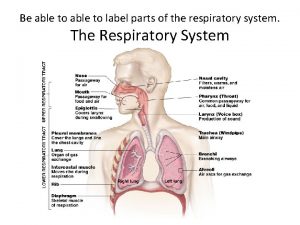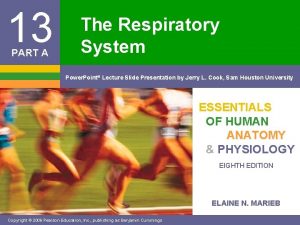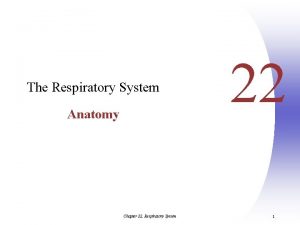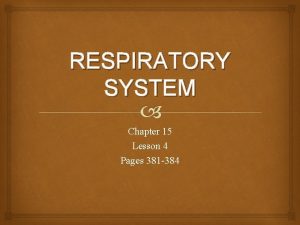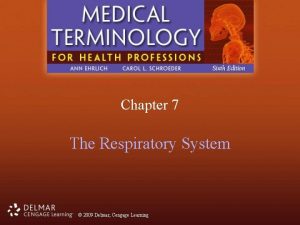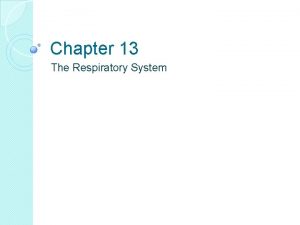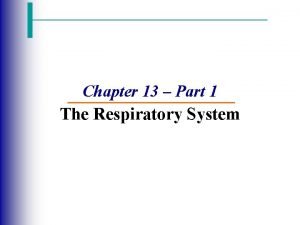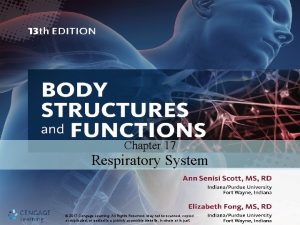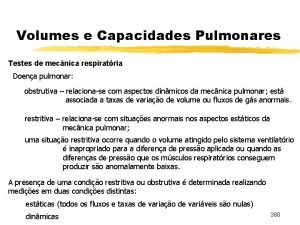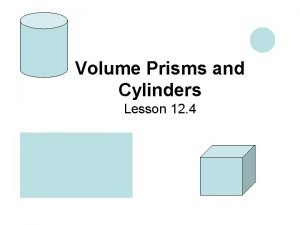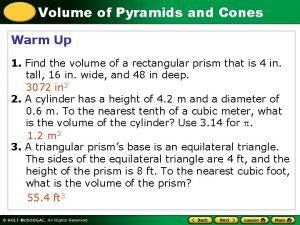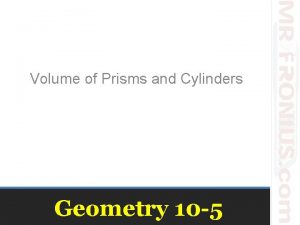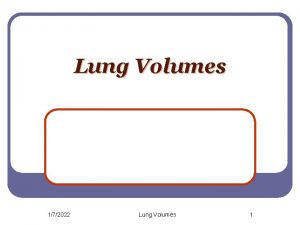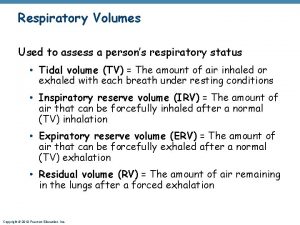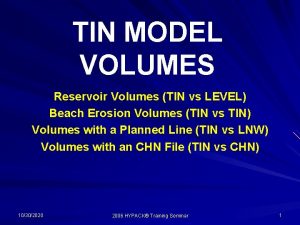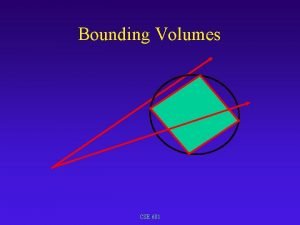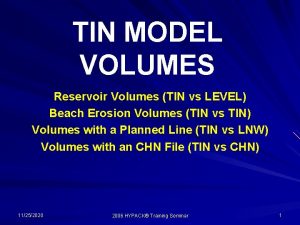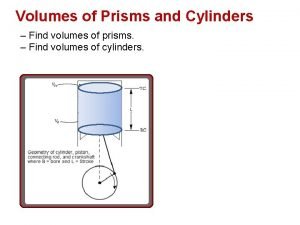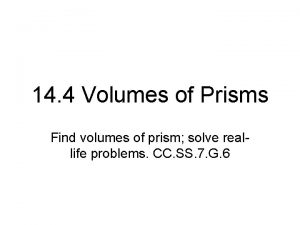Chapter 22 Respiratory System Respiratory Volumes Respiratory Volumes




















- Slides: 20

Chapter 22: Respiratory System Respiratory Volumes

Respiratory Volumes and Capacities • Respiratory volumes The amount of air that is flushed in and out of the lungs • Respiratory capacities Specific sums of the respiratory volumes • Spirometer measures respiratory volumes

Respiratory Volumes • Tidal volume (TV)– during normal quiet breathing the amount of air that moves into and out of lungs – 20 yrs 155 lbs 500 ml

Respiratory Volumes • Inspiratory reserve(IRV) – the amount of air that can be inspired forcibly beyond the normal inhalation (2100 – 3200 ml)

Respiratory Volumes • Expiratory reserve (ERV)– the amount of air that can be evacuated from the lungs after normal exhalation (1000 – 1200 ml)

Respiratory Volumes • Residual volume (RV) – the amount of air left in the lungs after the most strenuous expiration (1200 ml) – Helps to keep the alveoli open and prevent lung collapse

Respiratory Capacities • Inspiratory Capacity (IC) – Total amount of air that can be inspired after a tidal expiration – IC = TV + IRV

Respiratory Capacities • Functional residual capacity (FRC) – Volume of air remaining in the lungs after a normal tidal expiration – FRC = ERV + RV

Respiratory Capacities • Vital capacity (VC) – Maximum amount of air that can be expired after a maximum inspiratory effort – VC = TV + IRV + ERV – Should be 80% of TLC

Respiratory Capacities • Total lung capacity (TLC) – Maximum amount of air contained in lungs after maximum inspiratory effort (sum of all volumes) – TLC = TV + IRV + ERV + RV

Anatomic Dead Space • Inspired air that fills the conducting passageways, but doesn’t contribute to gas exchange • About 150 m. L • Easy way to determine your ideal weight in pounds is dead space in m. L

Coughing • A long-drawn and deep inhalation followed by complete closure of glottis, which results in a strong exhalation that suddenly pushes the glottis open and sends a blast of air through the upper respiratory passages. Stimulus may be a foreign body lodged in larynx, trachea, or epiglottis

Sneezing • Spasmodic contraction of muscles of exhalation that forcefully expels air through the nose and mouth. Stimulus may be an irriatation of the nasal mucosa

Yawning • A deep inhalation through the widely opened mouth producing an exaggerated depression of the mandible. It may be stimulated by drowsiness, fatigue, or someone else’s yawning. Precise cause is unknown

Hiccupping • Spasmodic contraction of the diaphragm followed by a spasmodic closure of the glottis, which produces a sharp sound on inhalation. Stimulation is usually irritation of the sensory nerve endings of the GI tract

Chapter 22: Respiratory System Transport of Respiratory Gases

Transport of Respiratory Gases • Oxygen Transport – Dissolved in the plasma – 1. 5 % • O 2 is poorly soluble in water

Transport of Respiratory Gases • Oxygen Transport – Bound to hemoglobin – 98. 5% • Hemoglobin (Hb) is composed of 4 polypeptide chains, each bound to an iron-containing heme group. • The iron binds the oxygen. Each hemoglobin can take 4 oxygen molecules. • After first oxygen binds, the Hb molecules changes shape each oxygen afterwards binds quicker than the last

Transport of Respiratory Gases • Carbon dioxide Transport – Dissolved in plasma – 7 - 10% – Bound to hemoglobin – ~20% • Binds directly to the globin • Doesn’t compete with oxygen transport – Bicarbonate ion (HCO 3 -) in plasma – ~70% • CO 2 + H 2 O H 2 CO 3 H+ + HCO 3 • CO 2 enters RBC and reaction takes place very quickly HCO 3 - moves from RBC into the plasma. • Reaction also takes place but at a much slower rate!

Respiration • External respiration Pulmonary gas exchange between lungs and the blood • Internal respiration systemic gas exchange between blood and the tissue • Cellular respiration blood to cells, cells use O 2 to break down food for useable energy (ATP)
 Label the parts of the respiratory system
Label the parts of the respiratory system Figure 13-6 is a diagram showing respiratory volumes
Figure 13-6 is a diagram showing respiratory volumes Conducting zone respiratory
Conducting zone respiratory Site:slidetodoc.com
Site:slidetodoc.com Tiny air sacs at the end of the bronchioles
Tiny air sacs at the end of the bronchioles Circulatory system and respiratory system work together
Circulatory system and respiratory system work together Chapter 7 cengage
Chapter 7 cengage Respiratory tree divisions
Respiratory tree divisions Perfusion in respiratory system
Perfusion in respiratory system The parts of the respiratory system in order
The parts of the respiratory system in order Chapter 7 the respiratory system labeling exercises
Chapter 7 the respiratory system labeling exercises Chapter 34 section 2 the respiratory system
Chapter 34 section 2 the respiratory system Chapter 13 the respiratory system
Chapter 13 the respiratory system Chapter 13 respiratory system worksheet
Chapter 13 respiratory system worksheet Chapter 17 respiratory system workbook answers
Chapter 17 respiratory system workbook answers Practice 10 6 volumes of pyramids and cones answers
Practice 10 6 volumes of pyramids and cones answers Espirometro jaeger
Espirometro jaeger Fictional character
Fictional character Volume of pyramids worksheet answer key
Volume of pyramids worksheet answer key Practice 10-5 volumes of prisms and cylinders answers
Practice 10-5 volumes of prisms and cylinders answers How to find volume of a semi circle
How to find volume of a semi circle
